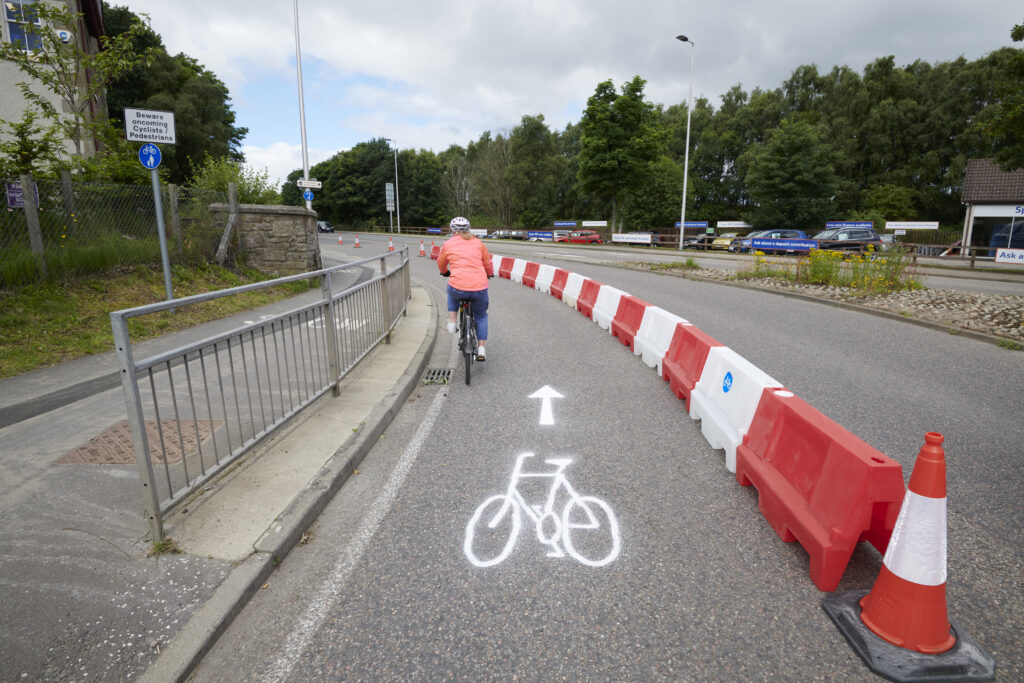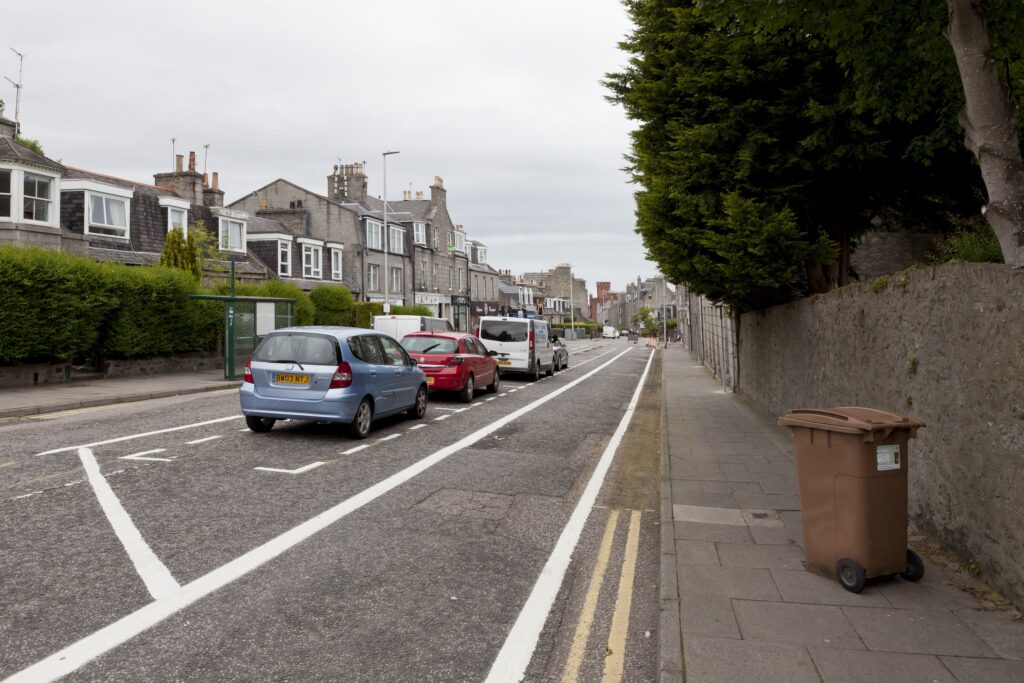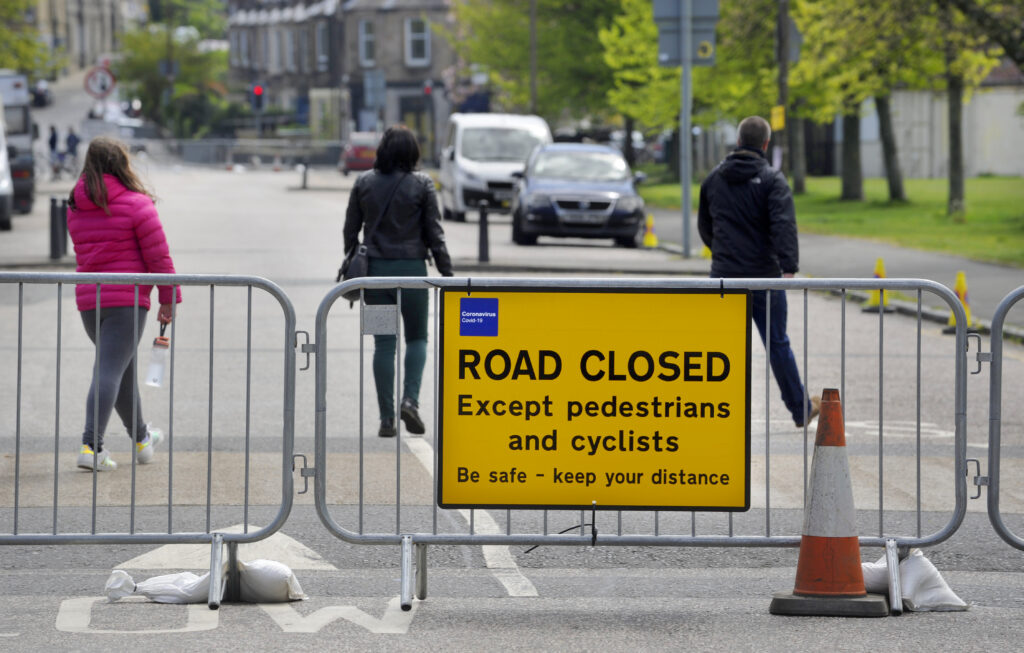This resource relates specifically to the Spaces for People programme, which is no longer open for applications. This page was reformatted in October 2021 to improve accessibility.
If you require access to any of the linked documents in an alternative format, please contact SpacesForPeople@sustrans.org.uk.
Design Guidance
This guidance has been developed to support partners with the implementation of temporary active travel facilities in Scotland, through Scottish Government’s Spaces for People fund, which is administered by Sustrans.
Spaces for People is designed to improve health and wellbeing so that everyone is able to move around their local area safely while keeping to physical distancing requirements as we transition through and out of the Covid-19 crisis.
Walking, cycling or wheeling in fresh air is not only positive for physical health, but also helps people feel connected in times of isolation, and can allow communities discover their neighbourhood.
Any temporary measures put in place should make an area better, and care should always be taken to ensure people with disabilities and other groups in need additional support are considered appropriately.
Overview
Atkins worked collaboratively with Sustrans to develop this content.
Content is derived from best practice examples from across the globe. It is intended to provide inspiration for the design of temporary facilities and should not be seen as a prescriptive design solution.
Each topic area includes advisory text, examples of best practice and minimum design parameters where applicable.
Each area also includes road safety and mobility impairment considerations to guide the designer to providing mitigating measures from the outset.
Appropriate road safety risk assessments should be undertaken during design and road safety audits undertaken at appropriate stages before schemes are open for public use.
Content will be regularly reviewed and updated by Sustrans Scotland.
Please Note: The ideas, products and suggestions within this document are provided for information only and in relation to temporary facilities to help with the management of physical distancing and movement across town and city centres during covid-19. It provides a collection of national and international examples of temporary infrastructure which may be of use in designing similar schemes across Scotland. Sustrans and Atkins do not accept any liability in relation to the use of the content of this document. Where specific products are shown in this document, this does not constitute an endorsement of that product.
Contents
Read the online guidance for the most updates versions where we will be revising the content based on feedback from our partners and adding case studies from project that have been delivered.
For offline access you can download the PDF using the chapter heading links below. We encourage you to check the relevant section online prior to developing your final design to ensure that you are using the most up to date advice.
PDF version (updated 31 July, 2020)

1.1 Widening Footways
1.2 Managing Pedestrian Flows
1.3 Public Transport Interaction

2.1 General Information
2.2 Temporary Cycle Lanes (One-way Travel)
2.3 Temporary Cycle Lanes (Two-way Travel)
2.4 Cycling on Quiet Streets
2.5 Junction Treatments
2.6 Parking, Loading and Taxi Ranks
2.7 Speed Management
2.8 Temporary Cycle Parking
2.9 Mobility Impairment and Safety Considerations
2.10 Signage

3.1 Modal Filters
3.2 Pedestrian Guardrail Removal
3.3 Providing Temporary Guardrailing
3.4 Transport Hubs
3.5 Parks and Open Spaces

4. Signage
4.1 Designing Signage for All
4.2 Advisory Signage for Covid-19
4.3 Walking and Wheeling Signage Principles
4.4 Cycling Route Signage Principles
4.5 Traffic Management Signage Principles
4.6 Walking and Wheeling Signage Examples
4.7 Cycling Route Signage Examples
4.8 Traffic Management Signage Examples
Timeline
Depending on the duration of time that temporary infrastructure is predicted to be in operation, different types of interventions may be more or less beneficial. The graphic below outlines some of considerations that might be made when selecting appropriate measures for differing timescales.
Although traffic cones and standing signage are effective in that they can be implemented quickly and easily, their utility is limited as a long-term solution. This is because of the ease with which they can be interfered with and otherwise circumvented. It is for this reason that semi-permanent solutions, such as heavy planters and bollards, may be more effective as long-term solutions.
The following downloadable PDF’s are flow charts which aim to articulate the possible project life cycle for delivering temporary active travel infrastructure, from receipt of funding to getting the infrastructure on the ground.
They include:
- Very quick, temporary traffic management style measures (cones, signs, etc)
- Semi-permanent interventions (bolt-down infrastructure, planters, etc)
Flow Chart for implementation of Temporary Active Travel Measures – Semi-permanent
Flow Chart for implementation of Temporary Active Travel Measures – Traffic Management
Please Note: These flow charts note indicative timelines which have been informed by timescales reported and observed, we are aware specific contexts mean these can vary considerably.
Walking and Wheeling
This section has been designed to provide a comprehensive overview of temporary infrastructure interventions as they relate to walking and wheeling. Reviewed August 17th 2020
Cycling Routes
This section has been designed to provide a comprehensive overview of temporary infrastructure interventions as they relate to cycling. Reviewed August 17th 2020
Traffic Management
This section has been designed to provide a comprehensive overview of temporary infrastructure interventions as they relate to traffic management. Reviewed August 17th 2020
Signage
This section has been designed to provide a comprehensive overview of temporary infrastructure interventions as they relate to signage. Reviewed August 17th 2020
Additional Resources
This section includes links to useful guidance around the delivery of temporary walking and cycling interventions. We will add to these links as more guidance becomes available.
Any guidance used should be applicable to your specific context. All interventions should comply with the relevant regulations in your context.
Public Health Scotland: Professional Briefing on Spaces for People
The Scottish Government: Coronavirus (COVID-19): safer public spaces – updated guidance
UK Government: Safer Public Places During Covid
Sustrans: Covid-adapted School Travel Measures
Transport Scotland: Guidance on Temporary Traffic Regulation Orders and Notices (COVID-19)
Department for Transport (DfT): Reallocating road space in response to COVID-19
Department for Transport (DfT): Traffic signs to support physical distancing
Urban Design Group: Fast Urban Change – a how to guide
Landscape Institute: Seven design principles for pop-up infrastructure
Transport For London: Streetspace for London guidance
Living Streets: A guide to low traffic neighbourhoods
National Association of City Transportation Officials: Streets for Pandemic Response and Recovery
The Mobility and Access Committee for Scotland (MACS): Temporary Street measures during Coronavirus crisis (updated October 2020)
Various Scottish Active Travel Organisations: Active Travel Code of Conduct


